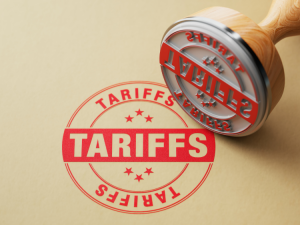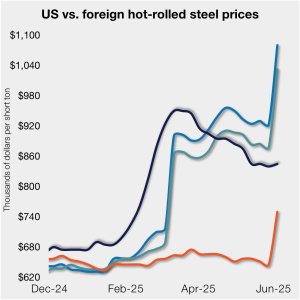Nippon/USS finalize 'partnership,' including US government 'Golden Share'
Nippon Steel and USS have finalized their "partnership" in a deal first announced in December 2023.
Nippon Steel and USS have finalized their "partnership" in a deal first announced in December 2023.

Getting back to the price increases I mentioned at the top of this article, to what extent are they aimed at raising prices and to what extent are they aimed at stopping the bleeding that was happening in the second half of May, before President Trump announced the 50% tariff?

The Trump administration has expanded the list of derivative steel products covered by the now 50% Section 232 tariff.
Cleveland-Cliffs plans to increase prices for hot-rolled (HR) coil to $950 per short ton (st) with the opening of its July spot order book. The Cleveland-based steelmaker said the price hike was effective immediately in a letter to customers dated Monday.

In short, when tariffs go up, jobs in consuming industries go down. There is conclusive evidence from past actions: safeguard tariffs in 2002 and Section 232 tariffs in 2018. It is happening again in 2025. The Trump administration wants foreign producers (and US retailers) to absorb tariff increases (except in antidumping cases, where foreign absorption of tariffs is illegal).
President Trump has approved the sale of U.S. Steel to Nippon Steel, according to an executive order signed on Friday, June 13. Both the Pittsburgh-based steelmaker and the Japanese steelmaker cheered the development.

If you’re feeling a sudden jerk and a case of tariff whiplash coming on, you’re not alone.

Steel equities and steel futures fell hard after news broke earlier this week that the US and Mexico might reach an agreement that would result in the 50% Section 232 tariff coming off Mexican steel. The sharp declines didn’t make much sense, especially if, as some reports indicate, Mexico might agree to a fixed quota. They didn't make sense even if steel flows between the US and Mexico remain unchanged.
President Trump says the US government will hold a 51% stake in U.S. Steel after the Nippon deal.

We’ll have a lot to talk about because construction is at the intersection of so many of today’s hot-button issues. The main question: Will construction thrive or dive in the rest of ’25? (Nothing wrong with a rhyme, even in serious times.)

Even before the news about Mexico, I didn’t want to overstate the magnitude of the change in momentum. As far as we could tell, there hadn’t been a frenzy of new ordering following President Trump’s announcement of 50% Section 232 tariffs. But higher tariffs had unquestionably raised prices for imports, which typically provide the floor for domestic pricing. We’d heard, for example, that prices below $800 per short ton for hot-rolled (HR) coil were gone from the domestic market – even for larger buyers.

Domestic hot-rolled coil prices edged up marginally this week, while offshore prices ticked down.

Timna Tanners, managing director of equity research for Wolfe Research, will be the featured speaker on the next SMU Community Chat. The webinar will be on Wednesday, June 11, at 11 am ET. It’s free to attend.

I think there is an obvious case for sheet and plate prices going higher from here. That’s because, on a very basic level, the floor for flat-rolled steel prices, which is typically provided by imports, is now significantly higher than it was a week ago.
President Donald Trump on Tuesday evening signed a proclamation that officially doubled Section 232 tariffs on imported steel and aluminum from 25% to 50%. There was one exception: Section 232 tariffs on steel and aluminum from the United Kingdom will remain at 25%, according to a fact sheet published by the White House.

Cleveland-Cliffs Chairman, President and CEO Lourenco Goncalves offered full-throated support for Section 232 tariffs on imported steel being doubled to 50%. And the top executive of the Cleveland-based steelmaker said the steel industry wanted to see as few exceptions as possible to the tariffs.
Meanwhile, several US trade groups applauded the latest trade announcement.
Section 232 tariffs of 50% on imported steel will go into effect on Wednesday with few exceptions, according to a top White House official.

Briefing on the stay motion will be completed by June 9. If a stay pending appeal is granted, it will likely remain in effect until the Court of Appeals issues a decision, which could be months in the future. The case is almost certain to be appealed to the Supreme Court.
At a rally celebrating a “planned partnership” between U.S. Steel and Nippon Steel, President Trump announced higher tariffs on steel and aluminum imports into the United States, and revealed few more details on Nippon’s investment in USS’ operations.

Timna Tanners, managing director of equity research for Wolfe Research, will be the featured speaker on the next SMU Community Chat. Timna has coined Sheet Storm, Galv Galore, and Rebarmageddon. Her forecasts and insights are always though provoking. And she’s not afraid to speak her mind. So it's no surprise that she's one of our most popular guests!

International trade attorneys discuss court decisions this week that left many importers, manufacturers, and even casual observers wondering: What’s next?

The “on again, off again” Trump tariff train continues to chug along, with several important court rulings this week.

I sort of expected big news last Friday and over the long, Memorial Day weekend. Because that's become more the norm than the exception for steel this year. Sure enough, Trump posted on Truth Social on Friday afternoon that he had given his blessing to a “partnership” between Nippon Steel and U.S. Steel. And then over the weekend we had market moving new on tariffs, this time involving the EU.

The European Union is fast-tracking trade negotiations with the US in the hope of avoiding the 50% tariffs threatened by President Trump.
The US government could acquire a stake in U.S. Steel as part of Nippon Steel’s $14-billion deal for the Pittsburgh-based steelmaker, according to various media reports. The Trump administration sees Washington, D.C., acquiring a “golden share” as part of the deal, according to an article in Kyodo News on Tuesday. This would give the US […]
Trump threatens EU with 50% tariff starting June 1.
The CFIUS report is in, but what it contains remains unknown.

Zekelman is known for his straight talk. And his company is one of the largest steel buyers in North America. So he’s got a better eye than most on steel market developments.

For those who don’t know, we have a monthly scrap survey. It’s very similar to our industry-leading flat-rolled steel survey. We cover market trends, pricing, and sentiment – which helps us keep our finger on the pulse of the scrap market. One thing we’ve learned lately from our surveys here at SMU: The lack of […]